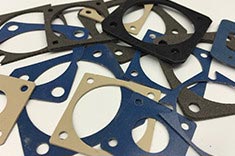EMI Shielding Products
- Custom Gasket Fabrication
- Connector Gaskets
- Bonded O Ring
- Custom Gaskets
- Conduct-O-Knit Knitted Wire Mesh
- Conduct-O-Seal Combo Gasket
- Conduct-O-Elastomer
- Conduct-O-Seal Oriented Wire in Silicone Gasket Material
- Conduct-O-Mesh Tape
- Conduct-O-Foam
- Conduct-O-Bond
- Optical Filters For Electronic Displays
- Shielded Vent Panels
- ESC Board Level Shielding
- 300 Series
Differences Between Types of Silicone Gaskets
Silicone gasket products are created when continuous sheet materials, or molded sheets, undergo the process of die cutting. Reliable gaskets have been made out of silicon for a long duration of time, as the material is extremely durable, flexible, and can be used in a variety of forms and applications. In general, silicone is heat resistant, has a low thermal conductivity and chemical reactivity, and is a suitable insulator. Almost every manufacturing industry has as an application for silicone gaskets as a result of silicone’s versatile qualities. They have superb resiliency, durability, heat resistance, and are available as molded gaskets, foam gaskets, solid gaskets, and injected molded gaskets. Custom silicone gaskets are available in a multitude of variations and have applications in the aviation, automobile, medical, and electronic industries. Below is an in depth explanation of the different varieties of silicone gaskets:

Solid Silicone Gaskets:
Solid silicone Gaskets can be produced through either die cutting or waterjet cutting operations. They have a wide hardness range that is measured in terms of durometers. Solid silicone gaskets can range from 10-70 durometers on the Shore A scale. Solid silicone gaskets are superior at heavy water sealant and submersion, offer a wide durometer and temperature range, can be molded, and are UV and Ozone resistant.
Sponge Silicone Gaskets:
In comparison to solid silicon, sponge gaskets are much softer. They are available in a variety of firmness levels and have excellent performance in sealing applications. Sponge silicone gaskets are UV and ozone resistant, have closed cells which prevent wicking, and can be die cut or water jet cut.
Silicone Foam Gaskets:
Silicone foam gaskets are very similar to sponge gaskets. However, silicone foam gaskets have a smooth skin and use platinum cured liquid silicone. Foam gaskets are available in a plethora of variations that have distinct differences in terms of cell structure. Silicone cell structure can be either open cell, or closed cell, which allows for different sealing properties and responses to environmental elements. Silicone foam gaskets are used for water spray sealing, are UV and Oxone resistant, have a wide temperature, and allow for sealing with low closure force.
Injection Molded Silicon Gaskets:
Silicon Gaskets that are produced through injection molding are products that offer incredible sealing integrity. They have a wide durometer and temperature range, allow for customizable three-dimensional parts to be built, and are UV and ozone resistant.
Related Reading about Shielding EMI
- EMI Gaskets and Shielding for the Modern Automotive Industry
- Three Most Common Questions about EMI Shielding
- Consideration for EMI Gasket Design
- Understanding How EMI and Electronic Devices Work Together
- Reduce Production Time and Cost when Partnering with Eastcoast Shielding



